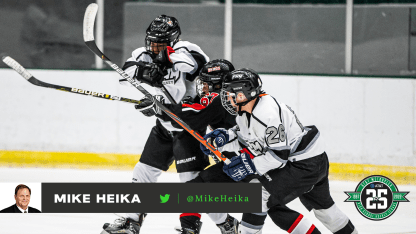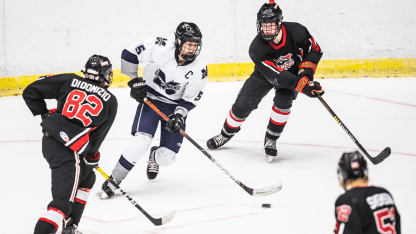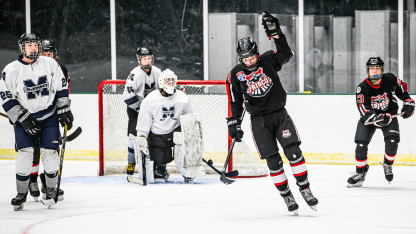Metroplex High School Hockey League celebrates 25th anniversary
The 54-team league will honor the 25th season in several ways, including having the original four schools wear patches and having individuals and teams from the past honored at Stars games

In 1997, that youth initiative spread to high school hockey. Starting with four teams in the spring - Southlake, Coppell, Plano and Jesuit - the
AT&T Metroplex High School Hockey League
has now built itself into a 54-team league that will celebrate its 25th anniversary this year.
While there are house and travel leagues that also allow young players to find success in the game of hockey, the high school league has a special place because of its passion.
"High school is different because in a lot of cases, hockey athletes are unique to hockey," said Comerica Center general manager Keith Andresen, who also serves as a leader in both the Texas Amateur Hockey Association and the Metroplex High School Hockey League. "Players in football or baseball might do multiple sports, but this is a chance for hockey players to play and have an identity with their school.
"That's important, because school is a big part of their lives and this gives them a chance to bring that together," Andresen added. "You go to a house game or travel game and it might be mom and dad or brother and sister, but you go to a high school game and there's a completely different feeling in the stands. Your peers are there, your teachers might be there. You can see the stands pretty full, and that really does help create an excitement that's different."

The Stars have pushed hard to have a balanced pyramid in youth hockey with a wide base of options for younger players that works up to a higher point with the top travel teams that could possibly lead to a future in the game. The high school part of the pyramid plays a big role because it's a visible goal for a lot of young players.
"It's really important in the Texas sports landscape," said Dan Stuchal, the Stars' senior vice president of marketing. "I definitely think younger players see in the future an opportunity to represent their high school, and that's a driving force for them. To know they can play a sport and represent their school and their colors, that's a big deal."
Stuchal came to Dallas with the North Stars from Minnesota in 1993 and grew up in Wisconsin, so he's seen the tremendous growth of the high school league in Texas. He said Andresen's contributions have been irreplaceable.
"I don't want to date Keith, but I refer to him as the grandfather of high school hockey in the State of Texas," Stuchal said. "He has almost single-handedly, because of his passion and his caring, made sure this league has been successful over time and that it is continuing to grow. I give him so much credit for making sure that those kids and those schools have a competitive place to play."
Andresen had a strong career coaching hockey in the Chicago area when a move brought him to Texas in 1997. He helped a group of youth managers that included Jouni Lehtola, Ed Reusch and Lance Lankford and lent his expertise with high schools to help grow the league.
"We've built on what others have done, Jouni, Ed Reusch, Lance Lankford, and I really do believe there has always been an attempt to bring the feeling of high school hockey from up north down here," Andresen said. "We turned it from four teams in the spring to 20 teams in the fall (of 1997), and it really took off from there."
The league in its heyday reached 72 teams, but then bankruptcy hit the organization and that hurt the overall hockey buzz in the community. The number of teams dipped to 34, but then Tom Gaglardi and his family bought the Stars in 2011.
"I definitely think we had a rebirth of sorts when Mr. Gaglardi took over," Andresen said. "Now, all those kids who started with Little Rookies or our other entrance programs, they're starting to become JV players. It's a great feeling to see that our initiatives are working. We have a lot of players who choose travel, but we also have a huge amount of players that are playing both travel and high school, who are playing house and high school or they're just playing high school. There's definitely a renewed interest."

The high school element is unique. Not only do players get to represent their schools, but they also get to bond with their classmates. Up north, high school hockey is treated just like football and basketball are treated in Texas with school leagues run by state associations. Here, however, Andresen and his crew have to scramble a bit. Often, there will be combined teams or players will just play for another high school. Andresen is trying to keep players in their regions or in their school districts.
"Every kid in the Metroplex is eligible to play high school hockey," Andresen said. "You don't have to attend the school. We have an open tryout in August that will allow kids that live in an area or attend a school that's unaffiliated to participate in the tryout. Then, the league will assign them to a team that needs players."
Andresen said he'd love to get to a place where each school can compete independently with both a varsity and JV, but that's down the road. In the meantime, officials want to keep things growing and keep things fair.
"It's a lot like high school sports where you track how communities build and where the younger population springs up," said Damon Boettcher, senior vice president, StarCenter facilities. "We didn't have any teams in Prosper when we first started, and now Prosper has three high school teams playing. That's part of the process, and we have to be aware of that as we build the league."
Boettcher has been a big part of opening up the suburban rinks after the COVID-19 shutdown and said earning the trust of parents and participants in youth hockey has been key. The high school league is in the middle of its summer season right now and said there needs to be a lot of credit given to everyone.
"We're pretty lucky down here because we've been able to get back in the building and get people back and earn their trust," he said. "I'm very proud of our staff and all of the changes and improvements we've made. We communicated with everyone and did everything we could to make sure everything was safe for the kids, and I know the parents appreciate that. It's a team effort, and I do think we've had success."
That's a similar formula for the success of the high school league. Andresen leads the way, but everyone chips in.
"Each club runs its own program, I manage the league, and I love it," Andresen said. "I've always had a passion for this. Being an old guy, I don't skate as much as I used to, so I love the fact that this is what I can do to promote the game."
The league will honor the 25th season in several ways, including having the original four schools wear patches and having individuals and teams from the past honored at Stars games. Area rinks will then host the USA Hockey National High School Tournament in March, which is just another feather in the cap of the Stars organization as it continues to grow the game in North Texas.
"There's a lot that goes into building a sport and I think one of the Stars' philosophies has always been that you need people playing to help build the fanbase," Andresen said. "And then if you take that another step, it just becomes obvious that you'd love to have that emotion and support for your school also tied to your hockey team, so that's a big part of what we've wanted to do here. We're all trying to grow the game of hockey, and this is a great part of that growth."
Victory Club memberships are available now for 2021-22! Beyond season tickets, don't miss your chance to secure the best seats for Stars home games, plus exclusive benefits, members-only experiences and much more. Click here to learn more!
This story was not subject to the approval of the National Hockey League or Dallas Stars Hockey Club.
Mike Heikais a Senior Staff Writer for DallasStars.com and has covered the Stars since 1994. Follow him on Twitter @MikeHeika, and listen to his podcast.


















